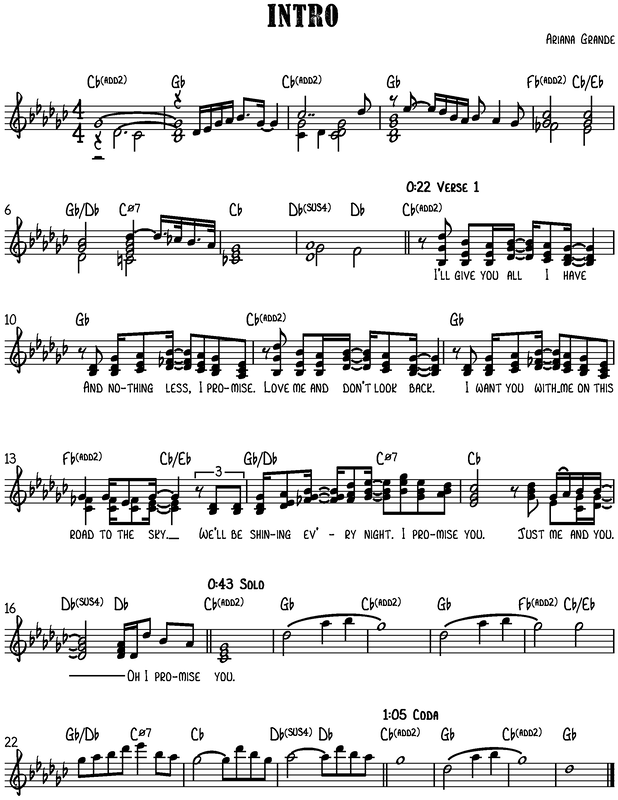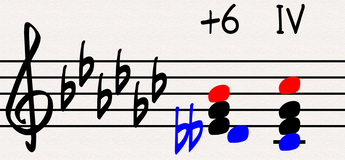|
Yesterday, while walking my puppy dog, I did what I always do: put in ear phones. I started with the audio book A Generation of Sociopaths: How the Baby Boomers Betrayed America by Bruce Cannon Gibney, but when that proved too depressing, I switched to music. A few days ago my wife commented on how she liked Ariana Grande's voice, so when I saw Grande's 2014 album My Everything in my library, I gave it a go. The first track, appropriately titled 'Intro', immediately captured my attention. First, a full structural analysis: 0:00-0:22 (A) Instrumental Introductory Verse (8) (a) statement (2) Cb | Gb (a) restatement (2) Cb | Gb (b) departure (2) Fb2 Cb/Eb | Gb/Db CØ7 (c) conclusion (2) Cb | Db4-3 0:22-0:43 (A) Verse 1 (8) (a) statement (2) Cb | Gb "I'll give..." (a) restatement (2) Cb | Gb "Love me..." (b) departure (2) Fb2 Cb/Eb | Gb/Db CØ7 "road to the sky..." (c) conclusion (2) Cb | Db4-3 "I promise you..." 0:43-1:05 (A) Instrumental Solo (8) (a) statement (2) Cb | Gb (a) restatement (2) Cb | Gb (b) departure (2) Fb2 Cb/Eb | Gb/Db CØ7 (c) conclusion (2) Cb | Db4-3 1:05-1:19 (A') Instrumental Coda (4) (a) statement (2) Cb | Gb (a) restatement (2) Cb | Gb Each section is fundamentally the same, despite surface-level differences, rendering the structure a Simple (or Strophic) design. The coda, though related, is clearly supplemental to the form because its abbreviated. You could argue that the intro is also supplemental (introductions are by definition supplemental), yielding an A x2 with intro and coda; however, since the intro is a full iteration of the module, I would count it as the first A section, making it an A x3 with coda. Either interpretation works, but I find the latter more accurate. That being said, it's not quite as straightforward as it might appear because Grande plays with the phrase rhythms during the solo. While the underlying harmonies retain the same two-measure hypermetric phrasing as the rest of the song, the melodic instrumental phrasing of the solo (starting in bar 17) through the coda is offset by one measure. This creates a greater sense of finality at the song's end by giving the impression of concluding on a hypermetrically strong beat, even though it's actually a weak beat. This is brilliant songwriting! Even more fascinating are the chords. Each departure phrase halves the harmonic rhythm, fitting two chords per bar (one chord every two beats, for a total of four chords in two measures), where the other phrases employ just one chord per bar (one chord every four beats, for a total of two chords in two measures). The fourth of those four departure phrase chords is the most unusual and interesting: It's a C half-diminished seventh (C-Eb-Gb-Bb). Half-diminished sevenths are rare in popular music. The Beatles used them in only two of their 211-song official catalog: 'Because' and 'You Never Give Me Your Money' (curiously, one Lennon song and one McCartney song, both from 1969's Abbey Road). No doubt there are other pop songs that employ this rare and intriguing harmony, but I can't think of any off the top of my head. Anyway, Ariana uses the half-diminished seventh somewhat differently than did John and Paul. (I don't know enough about Grande to know if she's a composer as well as a singer, but for the sake of this blog I will assume she is.) All three songwriters use the chord as a pre-dominant, but where The Beatles always employ it as a ii chord, Grande's use of the same harmony is not so evident. This ambiguity stems from the fact that it's almost several other chords, but not quite. Interpretation One: vi/#4 At its simplest, it could be interpreted as a conventional vi chord, but with a #4 (or b5) in the bass. This would render the progression (technically a retrogression) as bVII-IV-I-vi (in Gb: Fb-Cb-Gb-eb), which appears totally reasonable to the eye, though I can't think of any other song to use that particular pattern in a single phrase. (The Beatles used it in 'Dig A Pony', but as incongruent constituents bridging two consecutive phrases.) The problem is I just don't hear it that way. In other words, yes, this interpretation looks good, but I don't think it accurately captures what I'm hearing. Interpretation Two: augmented sixth What I'm hearing, that the above interpretation neglects, is how the C and Bb function like an augmented sixth chord. Enharmonically reinterpreting the C as Dbb gives it properly spelled augmented sixth function, as it resolves by half step down to Cb (shown in blue in the example below), just as the Bb resolves up to the same pitch class (shown in red). Okay, so now it does reflect what I'm hearing. But this "fix" creates a few new complications:
Interpretation Three: CTØ7 Common tone diminished chords are standard - they're a staple of romantic and barbershop styles. So could this mystery chord in 'Intro' be one? I have two problems with that notion. First of all, common tone diminished chords are usually common tone fully diminished seventh chords, where this would be a common tone half-diminished seventh - something I've never encountered before in any style or context. And second, common tone diminished chords are "supposed" to keep the root as the common tone, where in this case the third and the fifth are common tones while the root is not. So, technically, yes, this is a common tone diminished - it's just not what music theorists normally mean when they use that term. The bottom line is: I have no idea how to interpret this chord. And that ambiguity makes for absolutely fascinating and engaging analysis and consideration.
In the face of all this ambiguity, it's difficult - maybe even impossible - to make any clear verdicts. Yet I can draw one conclusion with utmost certainty: I'll be listening to a lot more Ariana Grande!
0 Comments
Your comment will be posted after it is approved.
Leave a Reply. |
Aaron Krerowicz, pop music scholarAn informal but highly analytic study of popular music. Archives
August 2019
Categories
All
|


 RSS Feed
RSS Feed
